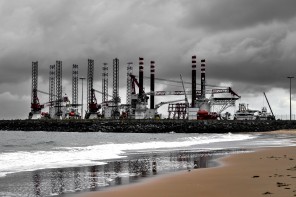From mid-2008 to 2009, the pound sterling lost around 36% of its value against the US dollar.
Usually, after strong and sustained moves in the market (a trend), there will be a cooling off period known as consolidation. During this period market participants take their profits or losses and decide where they think price will go next. Consolidation periods are marked by uncertainty and indecision. There is no clear direction of price; it is bound by a range.
The consolidation for the Pound, or GBP/USD, is in the form of a symmetrical triangle. There are many chart patterns for consolidation, with triangles being among the most common. In a symmetrical triangle pattern, the lows are getting higher and the highs are getting lower. Price extremes are converging as both bulls and bears are losing steam. In this case, price is converging to the psychologically important round price of 1.6000. Now the point of price patterns is that they can sometimes help us understand what price will do in the future. With enough of a sample size, we can be reasonably confident of the accuracy of patterns in predicting price action.
Since triangles appear every day over multiple time frames for financial instruments across the world, it is reasonable for us to use the ensuing behavior of these triangles for predictive purposes. Remember, though, that, like anything else in trading, patterns are not a magic crystal ball; they simply improve your chances of being correct on direction.
What are the defining characteristics of this pound consolidation triangle? First let us look at its width in time. The triangle, as a whole, if we extend to the end, goes from 2009 to 2014. That is a 5 year triangle. This baby is huge, and therefore incredibly critical. The bigger the triangle, the more important it is. Why? Because it is obvious and everyone in the market can see it. Second, we look at the height of the triangle and we see that it is about 3700 pips, also very large. Third, we see that it is a symmetrical triangle, where both the upper resistance and lower support (red lines), are converging. This implies that there is no directional bias within the market for this triangle.

Height: 3700 pips
Width: 5 years
Directional Bias: none
So what?
The implication of a consolidation pattern of such magnitude is that once it breaks, the ensuing move will be just as big. All consolidation patterns break. This means that the investors who were previously undecided on price direction have now taken action. Therefore, the consolidation pattern breaks through its support or resistance level as either the bulls or bears take power of the market. Because this is a symmetrical pattern with no directional bias, we cannot reasonably predict in what direction it will break, but we know that it will.
Of course there is one caveat. Some triangles never break at all and price fizzles out to the very end point, which is, in this case, early 2014. When this happens, the triangle should be considered invalid and trading based on triangles should be avoided. As you may have inferred, triangles should always break before their end points. Since we are nearing the end point, this break could be very soon.
We don’t know what direction the break will be in, but be ready for it when it comes because this could be a wave worth catching.





